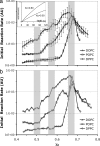Assess the nature of cholesterol-lipid interactions through the chemical potential of cholesterol in phosphatidylcholine bilayers
- PMID: 17372226
- PMCID: PMC1838487
- DOI: 10.1073/pnas.0611450104
Assess the nature of cholesterol-lipid interactions through the chemical potential of cholesterol in phosphatidylcholine bilayers
Abstract
Cholesterol plays a vital role in determining the physiochemical properties of cell membranes. However, the detailed nature of cholesterol-lipid interactions is a subject of ongoing debate. Existing conceptual models, including the Condensed Complex Model, the Superlattice Model, and the Umbrella Model, identify different molecular mechanisms as the key to cholesterol-lipid interactions. In this work, the compositional dependence of the chemical potential of cholesterol in cholesterol/phosphatidylcholine mixtures was systematically measured at high resolution at 37 degrees C by using an improved cholesterol oxidase (COD) activity assay. The chemical potential of cholesterol was found to be much higher in di18:1-PC bilayers than in di16:0-PC bilayers, indicating a more favorable interaction between cholesterol and saturated chains. More significantly, in 16:0,18:1-PC and di18:1-PC bilayers, the COD initial-reaction rate displays a series of distinct jumps near the cholesterol mole fractions (chi(C)) of 0.15, 0.25, 0.40, 0.50, and 0.57 and a peak at the cholesterol maximum solubility limit of 0.67. These jumps have been identified as the thermodynamic signatures of stable cholesterol regular distributions. In contrast, no such jumps were evident in di16:0-PC bilayers below chi(C) of 0.57. The observed chemical potential profile is in excellent agreement with previous Monte Carlo simulations based on the Umbrella Model but not with the predictions from the other models. The data further indicate that the cholesterol regular distribution domains (superlattices) are not the hypothesized condensed complexes. Those complexes were mainly implicated from studies on lipid monolayer that may not be relevant to the lipid bilayer in cell membranes.
Conflict of interest statement
The authors declare no conflict of interest.
Figures




References
Publication types
MeSH terms
Substances
LinkOut - more resources
Full Text Sources
Medical

